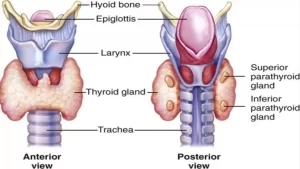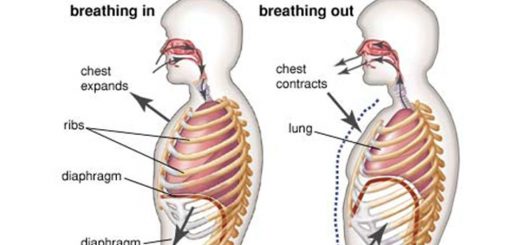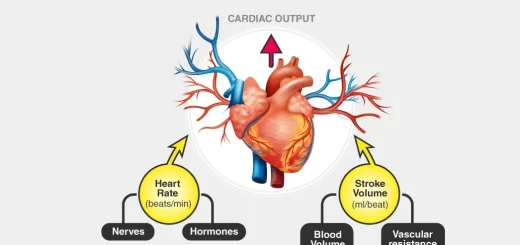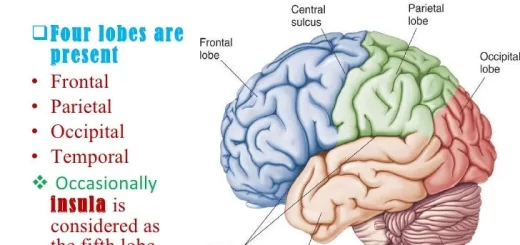Histological structure of thyroid gland and Functions of Thyroid Hormones (T3 and T4)
The thyroid gland secretes many hormones, collectively called thyroid hormones, The thyroid gland consists of two lobes, the right & the left lobes joined together by an intermediate structure, the isthmus, It is located in the anterior part of the lower neck, below the larynx (voice box), It secretes hormones vital to metabolism & growth.
Histological structure of the thyroid gland
A- Stroma
It is covered by a double capsule, the outer is the pretracheal gland fascia, and the Inner is the true CT capsule of the gland. The capsule sends fibrous septa dividing the gland into incomplete lobes and lobules. The stroma carries the blood vessels, nerves, and lymphatics of the gland. Reticular fibers extend from the septa and form a network supporting the thyroid parenchyma.
B- Parenchyma
It is composed of follicles, which appear in histological sections round to oval of different sizes. The follicles are surrounded by a network of fenestrated blood capillaries, The follicles are lined by cuboidal cells and contain a gelatinous eosinophilic material in their lumina called colloid, The follicles are lined by two types of cells which are follicular cells & parafollicular cells.
1- Follicular cells
By LM:
- They are cuboidal cells with central rounded nuclei and basophilic cytoplasm resting on the basement membrane.
- These cells change their shape according to the degree of activity. They become columnar when they are active and squamous when they are inactive.
By EM:
- They show the ultrastructural features of active protein secretion, as well as endocytosis and digestion.
- Numerous profiles of rER are present in the basal region
- Supranuclear Golgi complex is associated with small secretory (vesicles containing thyroglobulin.
- The cell membrane at the luminal border has a moderate number of microvilli.
- Follicular cells also contain abundant apical lysosomes and endocytotic vesicles.
Function:
Secretion of thyroid hormones (T3 and T4), The thyroid gland is the only endocrine gland that stores big quantities of its hormones in an inactive form extracellularly in the follicular lumen as a colloid.
Steps of synthesis and secretion of T3 and T4
- Synthesis of thyroglobulin: The follicular cells synthesize the protein part of the glycoprotein, thyroglobulin, by the rough endoplasmic reticulum. The Golgi apparatus adds carbohydrate intra-cellularly to the thyroglobulin. Thyroglobulin secretory vesicles are discharged into the lumen of the follicle by exocytosis where thyroglobulin contributes in the formation of the colloid.
- Uptake of iodide: The follicular cells also trap iodide from the capillary bed around the follicles and liberate it as iodine in the follicular lumen. Iodination of thyroglobulin takes place extra-cellularly in the colloid.
- Formation of T3 & T4: by coupling reaction in the colloid, where they are stored in the lumen of the follicle.
- Release of T3 & T4 into the circulation: In response to TSH, the colloid is endocytosed by the follicular cells in large endocytotic vesicles. Lysosomes fuse with the endocytosed colloid which is hydrolysed to free T3 and T4. The free hormones are released from the baso-lateral side of the follicular cell into the fenestrated blood capillaries surrounding the follicles.
2- Parafollicular (Clear cells or C cells)
These cells are found as part of the follicular epithelium, scattered between the follicular cells or as isolated clusters between the follicles. They form about 0.1% of the follicular epithelium.
By LM:
- They are larger than the follicular cells with pale cytoplasm and so are called clear cells.
- Their basal surfaces rest on the follicular basement membrane but their apical surfaces never reach the lumen of the follicles.
By EM:
- A moderate amount of organelles of polypeptides secreting cells.
- The Golgi complex is infranuclear.
- The secretory granules are small, dense, and basal towards the capillary bed.
Function: Secretion of calcitonin hormone.
The Interfollicular cells are tangentially cut follicles so appearing as clumps of cells without a lumen, They may be follicular or parafollicular cells.
Functions of Thyroid Hormones (T3 & T4)
They have a widespread effect because it stimulates oxygen consumption (calorigenic action).
A) Metabolic functions
1- On metabolic rate:
Thyroid hormone does not have any discrete target organs, It affects almost every tissue in the body as it stimulates oxygen consumption (calorigenic action).
They increase the metabolic rate and oxygen consumption of almost all tissues of the body. The basal metabolic rate can increase to as much as 60 to 100% above normal when large quantities of the hormones are secreted.
2- They increase the synthesis of many Intracellular enzymes and increase their activity as Na+ K+-ATPase which increases the rate of transport of both sodium and potassium through the cell membrane. This process utilizes energy and increases heat production i.e. increases metabolic rate.
3- On mitochondria: They increase the size, number, and activity of mitochondria, and this, in turn, Increases the rate of formation of ATP to energize cellular function.
4- On protein synthesis:
- Small doses of thyroid hormone increase the rate of formation of proteins by the ribosomes, It increases RNA synthesis by the genes, which leads to a generalized increase in the synthesis of many types of protein within the cells.
- Large doses of thyroid hormone lead to excess catabolism of muscle protein.
5- On carbohydrate metabolism:
- It increases the rate of absorption of carbohydrates from the gastrointestinal tract, thus the blood glucose level increases after carbohydrate meals, However, it normally falls again rapidly because the rate of glucose utilization is also increased.
- It enhances gluconeogenesis.
6- On fat metabolism:
- Al aspects of fat metabolism are increased under the effect of thyroid hormone including synthesis, mobilization, and utilization.
- The thyroid hormone accelerates the oxidation of free fatty acids by the cells.
- The lipolytic effects are more enhanced than the lipogenic effect.
- They lower the level of cholesterol, phospholipids and triglycerides in the blood.
7- Thyroid hormones are necessary for the hepatic conversion of carotene vitamin A.
B) On growth and development
- On skeletal growth and development: Thyroxine is essential for the normal growth of soft tissue and the skeleton due to its stimulation to protein synthesis. Thyroid hormones are required for the production and action of growth hormones and insulin-like growth factors.
- On nervous system: Thyroid hormone promotes growth and development of the brain during fetal life and for the first few years of life. The thyroid hormones are essential for normal myelination and development of the nervous system in infants. If there is a deficiency in thyroid hormone growth and maturation of the brain is retarded myelination is defective the reflex time is prolonged, In adults, the thyroid hormone causes an increased response of the brain to catecholamine and increases activation of the reticular activating system, An excess of thyroid hormone leads to restlessness and hyperexcitability.
C) The cardiovascular system
- Thyroid hormone increases the number and affinity of B-adrenergic receptors in the heart: it also increases its sensitivity to catecholamines. (catecholamines increase all properties of the heart).
- Increased metabolism in the tissues causes more rapid utilization of oxygen and causes greater metabolic end products to be released from the tissues, These effects cause vasodilatation, thus increasing the rate of blood flow in the skin for heat elimination.
- Increase blood flow leads to increase venous return leading to an increase in cardiac output so the systolic blood pressure rises. but vasodilatation causes a decrease in diastolic blood pressure thus, pulse pressure is increased.
D) On respiration:
Thyroid hormone increases respiration due to an increased rate of metabolism which increases the utilization of oxygen and the formation of carbon dioxide. Also, it helps dissociation of O2 from heamoglobin by increasing the amount of 2.3 diphosphoglyceride (DPG) in the RBCs.
E) On the GIT
They increase the rate of secretion of the digestive juice and motility. This leads to increase appetite and food intake.
F) On sexual functions
For a normal sexual function to act thyroid hormone secretion needs to be approximately normal. Thyroid hormones are essential for normal menstrual cycles and fertility. They increase milk secretion in lactating women.
You can follow Science Online on YouTube from this link: Science online
Thyroid gland function, hormones, function, anatomy and Congenital anomalies
Posterior pituitary gland hormones & function, Control of ADH and Oxytocin hormone
Anterior pituitary gland function, hormones, location and Effects of Growth Hormone
Pituitary gland function, structure, location, hormones and anatomy
Endocrine system structure, function, disorders, Endocrine Glands and Hormones types




